If you’re just starting with meditation, try simple techniques like breathing meditation to focus on your breath and stay present, or do a body scan to relax tension by noticing sensations in different parts of your body. Guided imagery helps you visualize calming scenes, while loving-kindness meditation cultivates positive feelings toward yourself and others. Mindful walking combines movement with awareness, making it easier to stay engaged. Keep exploring these methods to discover what best supports your journey to calm and clarity.
Key Takeaways
- Start with simple breathing meditation to focus on inhaling and exhaling, building mindfulness and reducing stress.
- Practice body scans to connect with physical sensations and promote relaxation without judgment.
- Use guided imagery to visualize calming scenes, enhancing sensory awareness and emotional well-being.
- Incorporate loving-kindness meditation to cultivate positive feelings toward yourself and others.
- Engage in mindful walking to combine movement with present-moment awareness and improve mental clarity.
Breathing Meditation
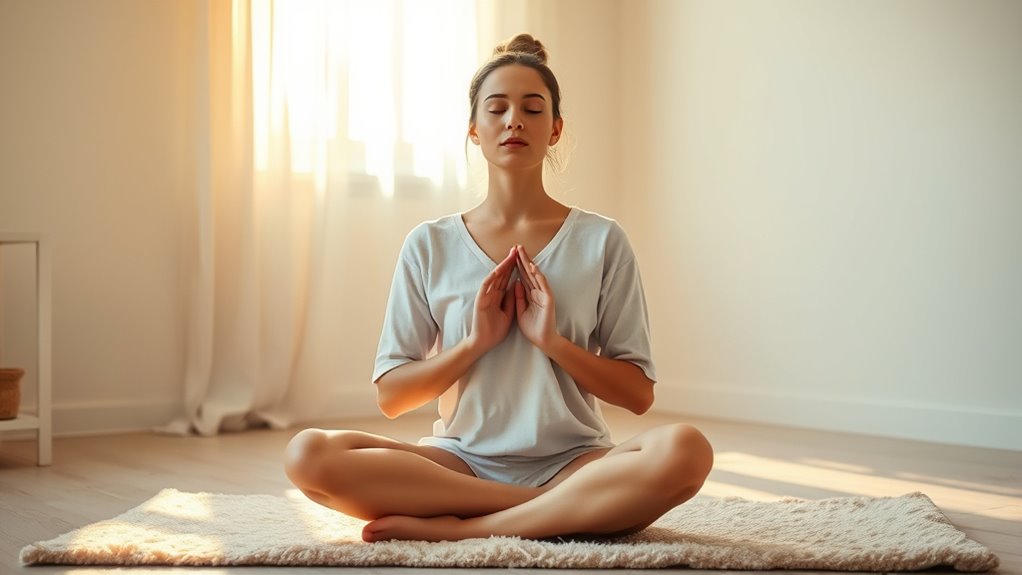
Have you ever wondered how simply focusing on your breath can calm your mind? Breathing meditation is a straightforward technique that offers many mindfulness benefits. By paying close attention to each inhale and exhale, you train your mind to stay present and reduce stress. However, meditation challenges like wandering thoughts or impatience can arise, especially for beginners. When your mind drifts, gently redirect your focus back to your breath without judgment. This practice not only calms your nervous system but also builds mental resilience over time. Consistency is key, and even a few minutes daily can make a significant difference. Breathing meditation provides a simple, accessible way to improve your overall well-being and develop a deeper sense of calm. Incorporating expert voice actors into guided meditations can enhance the experience and deepen your focus.
Body Scan Practice
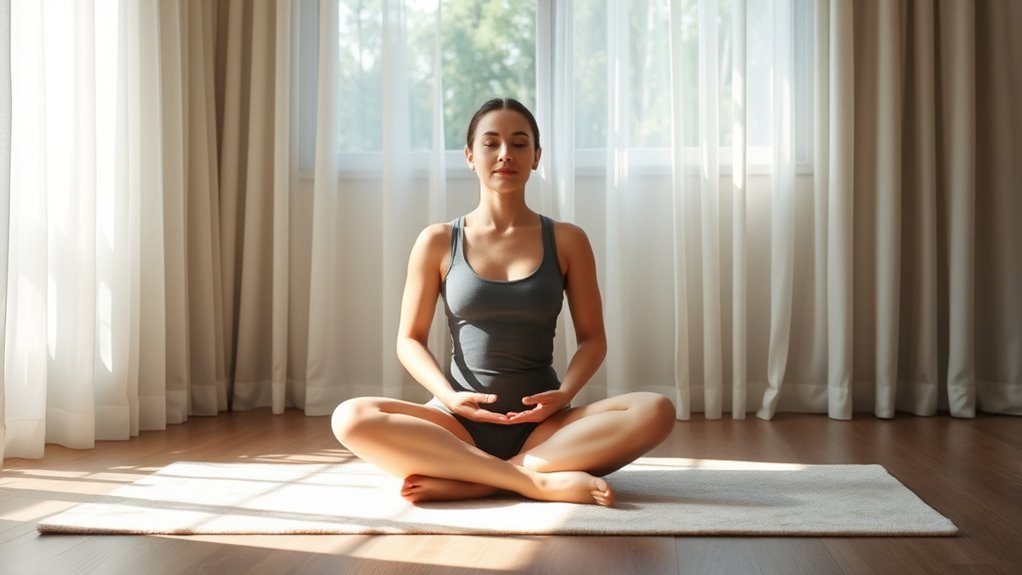
A body scan practice is a mindful exercise that helps you connect with your physical sensations and release tension. You start by lying down comfortably or sitting quietly, then slowly bring your attention to different parts of your body. As you focus on each area, notice any sensations, tightness, or discomfort without judgment. This enhances your body awareness, making you more attuned to how your body feels throughout the day. By consciously observing these sensations, you encourage tension release, helping your muscles relax and calming your mind. The practice encourages you to stay present, fostering a deeper connection with your physical self. Regularly practicing the body scan can reduce stress and improve overall relaxation, making it a valuable tool for beginners seeking mindfulness. Using mindfulness techniques during this exercise can deepen your relaxation experience.
Guided Imagery
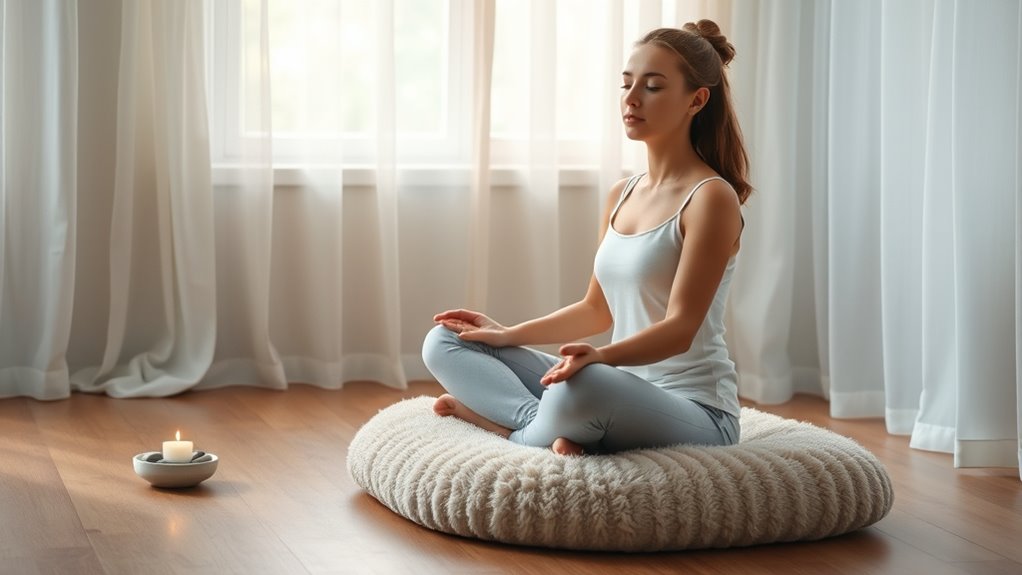
Ever wondered how your mind can create calming images to ease stress? Guided imagery uses visualization exercises to help you do just that. By focusing on mental pictures, you activate your sensory awareness, making the experience more vivid and grounding. You might imagine walking through a peaceful forest, feeling the cool breeze and hearing birdsong, or visualize a tranquil beach with warm sand and gentle waves. As you engage your senses, you deepen relaxation and calm your mind. Guided imagery is simple to practice: find a quiet spot, close your eyes, and let your imagination take over. This technique helps reduce anxiety and enhances emotional well-being by training your mind to access peaceful, positive images whenever needed. Incorporating visualization techniques can further enhance the effectiveness of your practice.
Loving-Kindness Meditation
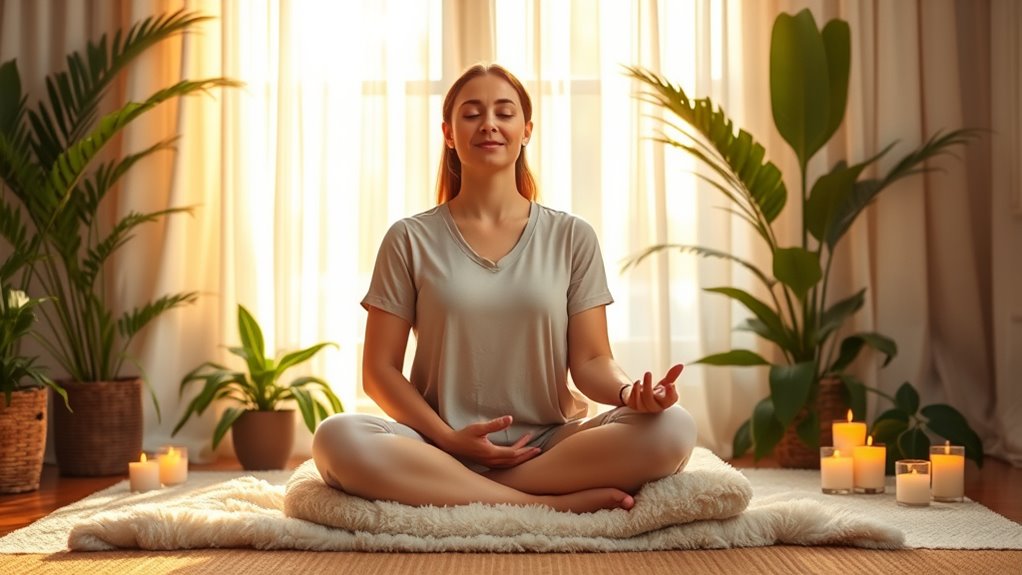
Building on the calming power of guided imagery, loving-kindness meditation focuses on cultivating positive feelings toward yourself and others. By intentionally sending well-wishes, you foster compassion cultivation, which deepens your emotional resilience. As you repeat phrases like “May I be happy, May I be healthy,” you reinforce kindness and understanding within yourself. This practice encourages you to extend these feelings outward, strengthening your connections and reducing negativity. Over time, loving-kindness meditation helps you develop a more accepting attitude, making it easier to cope with stress and emotional challenges. Consistent practice boosts your capacity for empathy and patience, nurturing a balanced, compassionate outlook that benefits both your mental health and your relationships. Incorporating mindfulness techniques into your routine can further enhance your emotional well-being and deepen your practice.
Mindful Walking

As you start mindful walking, choose comfortable shoes to support your feet and stay relaxed. Focus on your breath with each step, feeling it naturally flow in and out. This simple attention helps you stay present and connected to your surroundings. Incorporating mindfulness practices during your walk can enhance your mental clarity and overall well-being.
Choosing Comfortable Shoes
Choosing comfortable shoes is essential for mindful walking because the right footwear helps you stay present and focused on each step. When selecting shoes, prioritize footwear comfort to prevent distractions and discomfort that can break your flow. Consider shoe material options like breathable mesh, soft leather, or cushioned fabric, which support foot flexibility and comfort. Your shoes should feel like an extension of your body, not a burden. To evoke emotion, reflect on this table:
| Comfort Level | Shoe Material Options | Feeling |
|---|---|---|
| Light as air | Breathable mesh | Freedom |
| Cushioned | Memory foam | Serenity |
| Supportive | Leather | Confidence |
| Flexible | Soft fabric | Ease |
Choose shoes that resonate with your journey, fostering calm and focus in every mindful step.
Focusing on Breath
Focusing on your breath during mindful walking helps anchor your awareness in the present moment. As you walk, pay attention to each inhale and exhale, using your breath as a natural focal point. This simple practice enhances your mindfulness exercises, helping you stay engaged and grounded. Concentration strategies like counting breaths or noting the sensation of air entering and leaving your body can deepen your awareness. If your mind wanders, gently redirect attention to your breath without judgment. The key is to remain consistent, using your breath as a steady anchor amidst movement. Over time, this technique improves your ability to stay present, making your mindful walking sessions more effective and calming. Additionally, understanding the principles of meditation benefits can motivate you to maintain this practice regularly.
Focused Attention Meditation
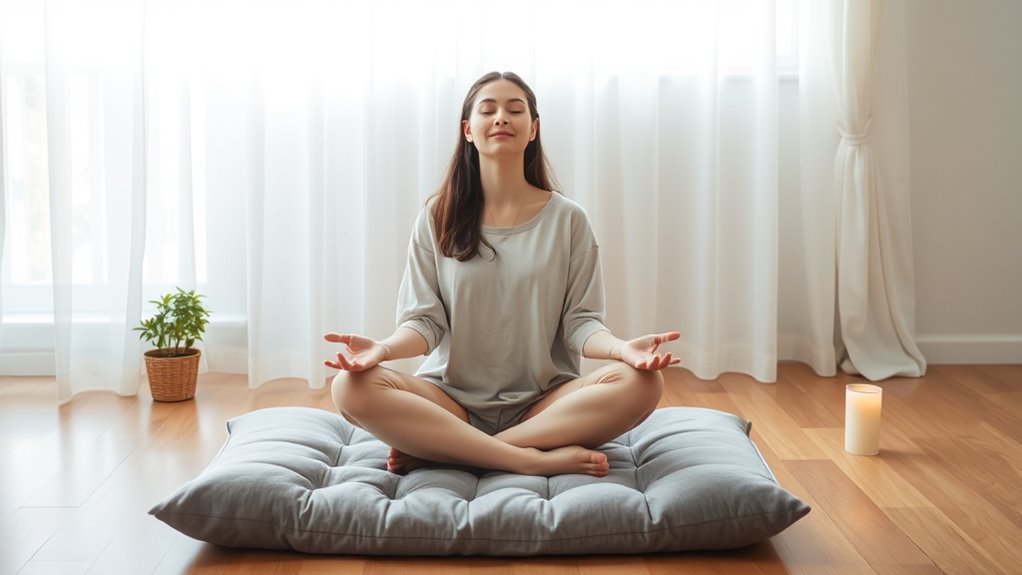
Focused Attention Meditation involves directing your full attention to a single object, such as your breath, a mantra, or a visual point. As you practice, you enhance your mindfulness awareness by consistently bringing your focus back whenever your mind wanders. This technique strengthens your concentration exercises, helping you develop a sharper mental state. To start, choose an object and gently fix your gaze or awareness on it. When distractions arise, acknowledge them without judgment and return your focus to the chosen object. Regular practice trains your mind to stay present, improve your attention span, and cultivate a calm, centered mindset. Focused Attention Meditation is a simple yet powerful way to build mental clarity and deepen your meditation experience. Incorporating focused attention techniques from other areas like mindfulness practices can further enhance your meditative skills.
Frequently Asked Questions
How Long Should a Beginner Meditate Daily?
For your daily practice time, start with a manageable meditation duration, like five to ten minutes. As you become more comfortable, gradually increase your meditation duration to 15 or 20 minutes. Consistency matters more than length, so focus on establishing a daily practice time that fits into your schedule. This approach helps you build a sustainable habit while experiencing the benefits of meditation without feeling overwhelmed initially.
What if I Can’t Clear My Mind?
If your mind wanders or you feel distracted, don’t worry—it’s normal. Instead of trying to clear your mind completely, focus on distraction management by gently bringing your attention back to your breath or chosen anchor. Accept that mind wandering happens and use it as part of your practice. Over time, you’ll notice better control and fewer distractions, making meditation more effective and enjoyable.
Is Meditation Suitable for Children?
Like Alice exploring Wonderland, you might wonder if meditation suits children. The answer is yes, especially with child-friendly techniques designed for young minds. Schools increasingly incorporate meditation in schools to help kids develop focus and calmness. Tailoring sessions to their age and interests makes meditation accessible, fostering mindfulness early. This gentle approach supports children’s emotional health, encouraging them to navigate life’s twists with clarity and resilience.
Can Meditation Help With Anxiety?
You might wonder if meditation can ease anxiety, and it definitely can. Practicing mindfulness benefits your mental health by helping you stay present and reduce stress. Breathing exercises are a key part of meditation that calm your nervous system. When you focus on your breath, you can lower anxiety levels and feel more in control. Regular practice helps you build resilience against future stress, making meditation a powerful tool for anxiety relief.
What Equipment Is Needed to Start Meditating?
To start meditating, you don’t need much equipment. A comfortable meditation cushion can help you sit with proper posture, making it easier to focus. Some people find that incense sticks create a calming atmosphere, enhancing relaxation. You might also consider a timer or soft music if it helps you stay focused. Overall, keep it simple—your mind and intention matter most, and minimal tools can support your practice.
Conclusion
As you explore these meditation techniques, remember that stillness and movement, focus and openness, are both essential. While breathing and body scans ground you, guided imagery and loving-kindness open your heart. Embrace the balance between quiet reflection and active awareness, knowing that each practice offers a unique path. In this dance of inward and outward attention, you’ll find peace not just in the stillness, but in the journey between thoughts and feelings.









